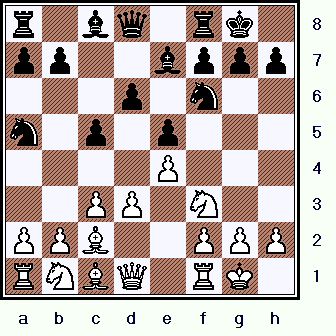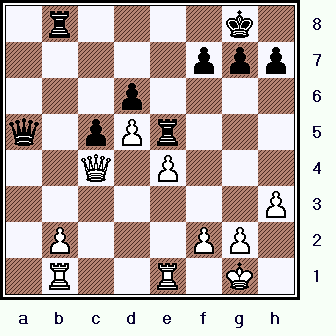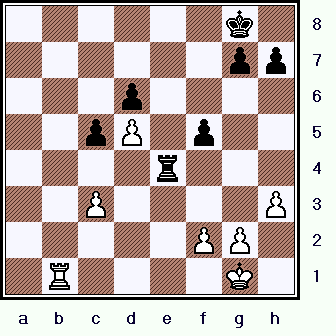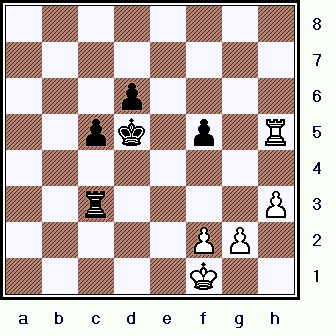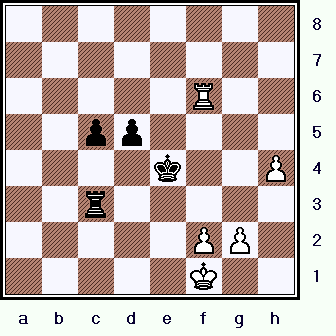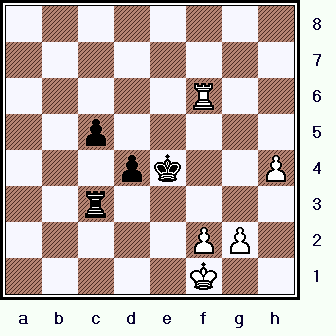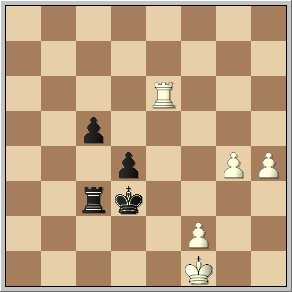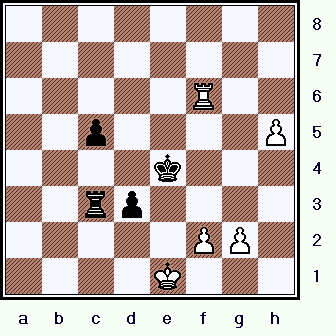All
the |
(Navigation bar
directly below.)
*******
© A.J. Goldsby, 2015.
(All rights reserved.)
****************
Click HERE
to see my
Chess Items.
****************
****************
Buy a book
from Amazon.com
(And help me out as well!)
****************
Click HERE
...
to see a list of the businesses that help to sponsor all of
my chess efforts.
Kudrin - Onischuk;
The 2006 U.S. Championships
I started working on this game right after it was played.
I
initially had in mind to crank this job out in thirty minutes to an hour ...
LOL!!!
(It does not seem as if I can do this anymore!)
This was a good game to look at for a number of reasons, most importantly, it might have been one of the key games in the whole of the U.S. Championship tournament. After I began working on it for a couple of days, I also realized that it would make an excellent addition to my R+P endgame school, at least if it was properly presented.
It was also a fascinating chess game in its own right - worthy of a deep and exhaustive examination.
Click HERE to see an explanation of the symbols that I commonly use when I annotate any chess game.
Click HERE to replay this game ... on another server.
GM Sergey Kudrin (2554) -
GM Alexander Onischuk
(2650)
|
|
|
r1bq1rk1/pp2bppp/3p1n2/n1p1p3/4P3/2PP1N2/PPB2PPP/RNBQ1RK1 w
Take a look at this position, we have a relatively balanced set-up here.
9.Re1 Re8;
10.d4!?,
I don't know whether or not theory would consider this break premature.
(Normally, in a Ruy Lopez - and related systems - the first player will preface the
d4-pawn-push with h2-h3. This is mostly to prevent the Black QB from going to g4 ... leaving White in an
uncomfortable pin.)
[ Maybe a little better was:
1; 11.Nbd2 Bf8; 12.Nf1 h6!?;All this is the contest:
GM Mihail Kobalia (2639) - GM Suat Atalik (2568);
[C55] / The Fourth European Champ. (EU-ch 4th) /
Istanbul, Turkey; (R#6) / 30,05,2003. (1-0, 50 moves.)
{White won a long and fairly difficult struggle.}And now: 13.Ng3 g6; 14.d4, "+/=" {Diagram?}
when White has a solid edge. (Albeit, a fairly small one.) ]
10...exd4;
11.cxd4 Bg4!?; 12.d5 Nd7;
Now - if you looked only at the Pawn structure - you might think that this position arose out of a Modern Benoni opening. (Except that Black has not fianchettoed his King's Bishop.)
13.Nbd2 Bf6;
14.Rb1,
The idea of this move is to target the Knight on a5, if Black is careless, he loses a piece to a3 and b4. (The move looks slight awkward and unnatural, but maybe there was nothing
significantly better?)
[ The play of 14.Qe2!?, was also possible here. ]
Onischuk's
next move gains him some space on the Q-side, often a little "elbow room" is just what Black needs the
most in this type of position.
14...b5;
15.h3 Bxf3;
Black decides to swap, so as not to lose a significant amount of time.
[ (>/=) 15...Bh5; was a decent and a very playable option for Black.) ]
Now comes a series of forcing moves.
16.Nxf3 Nc4!?;
17.Bd3 Rb8; 18.a4 a6; 19.axb5 axb5;
20.Qe2 Qa5;
21.Bxc4 bxc4;
22.Bf4, ('!')
This is probably White's best (and wisest) option here.
[ Also possible was: 22.Qxc4!? Ne5!; 23.Qe2, {Box.}( Not </= 23.Nxe5?? Qxe1+; etc. )
23...Nxf3+; 24.gxf3 Qa4; "~" with some play against White's
three Pawn islands and slightly more exposed King. ]
Now Black must defend e6, and also be on guard against a possible pawn push, (e4-5
at some point). Onischuk finds the simplest solution to all of these possibilities.
(Simplify!)
22...Be5;
23.Bxe5 Nxe5;
24.Nxe5 Rxe5; 25.Qxc4, {See
the diagram below.}
Liquidating ... and gaining an extra Pawn, but allowing some play in the process.
|
|
1r4k1/5ppp/3p4/q1pPr3/2Q1P3/7P/1P3PP1/1R2R1K1 b
Now we can see the R+P ending is coming up, and this is the phase of the game that I wish to draw your attention to.
[ Or White could try: (>/=) 25.f4 Ree8; 26.Rbc1 Rb3; "<=>"
but Black has some play here as well. ]
25...f5;
26.Qc3!?, hmmm
Kudrin decides to trade down ...
it looks like he does not believe that his position was superior.
[ Probably a little better was:
>/= 26.Ra1! Qb4; 27.Qxb4 Rxb4; 28.exf5 Rxf5; 29.Ra8+, "/\"
when White is dictating play in this ending and White still has
an extra Pawn. (Of course, this might objectively be "only a draw,"
but even so, that would have been a better result for White than the
actual course of the game!) ]
The next series of moves is all (pretty much) forced - for both parties here.
26...Qxc3;
27.bxc3 Rxb1;
28.Rxb1 Rxe4; "Equal"
("=")
{Diagram below.}
The program considers this position to be basically level, and I would have to agree with
that.
|
|
6k1/6pp/3p4/2pP1p2/4r3/2P4P/5PP1/1R4K1 w
Take a long look at this position, what move should White play here?
29.Kf1!?,
(A bad decision by White?)
This prevents Onischuk from playing his Rook to the seventh rank, but at this point, you have to
be wondering what is going through Kudrin's mind. (Does he think he has winning
chances in this particular R+P endgame? If he does not think he is winning, then why not just force the draw here?)
Of course, if White goes on to lose the game and no improvement can be found from here, then this could be considered a crucial, key turning point of the whole struggle.
[ Possibly superior was:
(>/=) 29.Rb6 Rc4; 30.Rxd6 Rxc3; 31.Rc6 c4; 32.f4, "=" {D?}
when White may not be better, but he is in absolutely no danger
of losing this endgame. ]
29...Kf7!;
(Maybe - '!!')
An extraordinary decision, you have to ask yourself why Black made up his mind to play in this fashion.
This play - while seemingly a little risky - is the only way for Black to maintain any winning chances.
[ By playing the moves:
29...Re5; 30.c4 Re4; 31.Rb6 Rxc4; 32.Rxd6,
we have basically transposed into the last note,
(the one given after White's 29th move). ]
The next couple of moves are forced.
30.Rb7+ Kf6;
31.Rd7 Ke5; ('!')
Part of the plan, in some lines Black is willing to sacrifice his entire Kingside mass for two, connected-passed-Pawns that roll up the middle of the board.
32.Rxg7 Kxd5;
33.Rxh7 Rc4; ('!') 34.Rh5 Rxc3!!; (A true sacrifice.)
{Diagram.}
Here it is, a very radical Pawn sack. Black is banking on his better King, slightly more active Rook, and the fact that his Pawns are more advanced than his opponent's.
|
|
8/8/3p4/2pk1p1R/8/2r4P/5PP1/5K2 w
If Black is right, he will have good winning chances - but if he is wrong, then he risks losing the game.
[ Or 34...Ke6; 35.Ke2 Rxc3; "~" when Black might be slightly better,
but possibly Onischuk did not feel it would be enough to win the game. ]
35.Rxf5+ Ke4;
36.Rf6 d5;
37.h4!?, hmmm
{See the diagram given - just below.}
This move looks to be {basically} the correct plan - at some point White must get his Pawns going.
|
|
8/8/5R2/2pp4/4k2P/2r5/5PP1/5K2 b
Maybe Re6+ here was an important alternative, as Black has a lot of choices to make ...
deciding where to put the King is no easy matter.
[ A sample variation - that shows some of the things that Onischuk
would have had to considered prior to playing this line would be:
37.Re6+ Kd3!?; Perhaps risky?
(I prefer this move - as the only real winning attempt for Black.)(The safest move would be 37...Kf5!?; "~" to hold the draw.)
Now the correct plan for White is to get his K-side Pawns rolling.
(Probably 38.g4 is the best way.)
38.Re3+!? Kc2; 39.Rxc3+? Kxc3; 40.Ke2 Kc2!; 41.h4 d4;
42.h5 d3+; "-/+" and Black rams his QP home.[I want to stress that there is NO ('!') chance that GM S. Kudrin would
make a mistake like exchanging the Rooks here, (unless he was
critically short of time!); I just gave this variation to illustrate some
of the problems that White is facing here.]This is also a common motif that has foiled many players of average
playing strength. ]
37...d4; "=/+" {Evaluate the position.} {See the diagram given below.}
Black's Pawns are a little more advanced than his opponent's ...
also the fact that they often will promote with check (in many of the key variations)
is significant as well. [And both Black's King and Rook are on much better squares than the opposing player's counterparts in this particular position.] The sum of all these integers means that Black must be (at least) a little better in this position, and that White's extra Pawn is of very little consequence. (Of course, if White had one Pawn less here, the game would probably be a simple win for Black.)
|
|
8/8/5R2/2p5/3pk2P/2r5/5PP1/5K2 w
This is the current situation that we now have on the chess board.
38.h5?!,
(Poor timing by Kudrin?)
It appears correct to get the White Pawns started on their journey up the board here, if White
delays this idea for any real length of time, he will certainly lose this ending. (Yet White's play must be a delicate balance here between getting his own Pawns moving up the board and, all the while, keeping an eye on Black's little buttons ...
and trying to restrict his opponent's counterplay as well.)
(Once more, the check with the WR {on the e6-square} was also a very serious option here for White.)
*** *** *** *** *** *** *** *** *** *** *** *** *** *** *** *** *** *** *** *** *** *** ***
RR ---> The computers notice a fairly substantial change in their evaluations after this move by White. Yet my analysis very STRONGLY indicates that White was already in some {grave?} difficulties before this move. {Therefore I feel it was illogical to react in a "knee-jerk" manner ... and brand this move as a major error.}
[ Not advisable would be:
</= 38.f3+? Kd3!; 39.g4!? c4; 40.g5 Rb3!; 41.g6 c3; "/+"
and Black's Pawns might be a bit more dangerous ...
(faster to promote) ... than his opponent's. {Maybe "-/+"}********************************************************************************
Perhaps an improvement over the game would have been the
continuation of: >/= 38.Re6+, ('!') 38...Kd3!?; The most aggressive?
(This is the most thematic move here, but I am not entirely certain that it
is the best play for Black.)( Or =38...Kf5 ; 39.Rd6 d3; "~" ("=/+") when Black still
looks pretty good in this position. )39.g4, ("=/+" or "/+") {See the analysis diagram - just below.}
with a position that is not all that easy to evaluate. (I spent almost
two whole weeks here investigating the various lines that arise from
this position. I like 39...Ra3!? from this position, but it is NOT entirely
clear exactly what continuation Black should choose from this particular
position!)
I found MANY wins for Black ... I also found a few winning lines for White.
However, in all of these variations, I eventually found some possible
improvements. This is why I chose to cut off the analysis at this point.Everything I said about the second player's position, (after Black's 37th
move - in the actual game); applies to this position as well. (Which is
why I evaluate it as Black having the advantage here.)Perhaps in time, someone will discover what the best continuation
would be ... from this crucial point in my analysis. ]
Now Black's next move threatens a simple mate in one ... of course Kudrin must immediately address this problem.
38...d3;
('!')
The most elegant solution ... to my way of thinking.
[ Also winning was:
("=") 38...Rc1+; 39.Ke2 d3+; 40.Kd2 Rc2+; 41.Kd1 c4; "/+"
(Maybe just "-/+") which is similar to the actual game, and may
not be anything more than a transposition of moves. ]
39.Ke1!?,
hmmm
{See the diagram
given, just below.}
GM Kudrin tries to use his most important piece to halt the advance of Black's foot soldiers.
This is probably inferior, however, Fritz 9 and Deep Junior are already beginning to see that White could be losing this endgame. (No matter which line Kudrin had chosen at this point in the struggle.)
|
|
8/8/5R2/2p4P/4k3/2rp4/5PP1/4K3 b
After this move, White's King gets into a jam. Threats of mate and the Black Pawns advancing (with check) compound an already difficult situation.
[The computer does not readily grasp all of this - the resulting positions are simply too many moves away ... over "the EVENT horizon."]
[ But of course not (the silly or inattentive): </= 39.h6?? Rc1#.
**********************************************************************
Maybe the best try was: >/= 39.Re6+ Kf5; 40.Re1 c4; "/+"
but the computer has already seen defeat coming up on the
(somewhat distant) horizon. ]
(Now many different programs prefer 39...c4 here - but my analysis shows that this line has no independent significance, and is probably nothing more than a simple transposition.)
39...Rc1+;
40.Kd2 Rc2+;
41.Kd1 c4; 42.h6, ('!?')
I don't think it matters anymore. (Most strong programs already consider White's game to be lost, at this particular point in this fascinating struggle.)
[ The continuation of: 42.f3+ Kd4; 43.Rd6+ Kc3; ("-/+") just
drives Black's King to a better (safer) place on the chess board. ]
42...c3;
43.Re6+, {Box?}
There isn't much choice now, 43.Rc6, RxP/f2 also looked pretty hopeless for White. (And now if White plays f3+, Black plays his King to the d5-square. White would then be virtually helpless against all the threats.)
[ After the simple moves of: </= 43.h7? Ra2; 44.Re6+ Kd5; "-/+"
White cannot avoid a rapid mate. ]
43...Kd5;
44.Re5+! Kc4; {Correct.}
Black avoids a relatively simple trap in this position.
[ Amazingly, Black could still risk losing this game by playing:
</= 44...Kxe5?; ('??') 45.h7 Rd2+; 46.Ke1 Re2+; 47.Kf1, '±'
when the second player cannot catch White's runaway KRP. ]
Now Onischuk wraps things up.
45.Re4+ Kb3;
46.Re3 Rd2+; "-/+"
Kudrin has seen the light at the end of the tunnel, and it is the onrushing five o'clock express.
(So he tenders his resignation at this point.)
[ After the straight-forward line:
46...Rd2+; 47.Ke1[], Forced.(</= 47.Kc1?? Ra2; "-/+")
47...Re2+!; 48.Rxe2 c2!; 49.Rxc2!? dxc2; 50.Kd2 Kb2;
51.h7 c1Q+; 52.Kd3 Qc2+; 53.Kd4 Qxh7; "-/+" {Diag?}
with a relatively easy win for Black from this point.**********************************************************************
Black could have {also} won with the following continuation:
46...d2; 47.Rd3, {Box?}
This could be forced, the other {main} alternative was also
not of any real help to White.( Or = 47.Ke2 Rc1; 48.Rd3, with a transposition.)
47...Rc1+; 48.Ke2 Re1+; 49.Kf3 d1Q+; 50.Rxd1 Rxd1; 51.g4,
If White advances his Rook Pawn, 51...Rh1 is a simple enough answer.51...c2; 52.h7 Rh1; "-/+" with an obvious win for Black. ]
A game of superb endgame mastery by GM Alexander Onischuk, who proves that he is a worthy U.S. Champion. (To win with the Black pieces against such a highly rated opponent is not an easy thing to do!!)
It is entirely possible that after White's regrettable decision on move 29, that Kudrin might be unable to save this contest. But I want to strongly emphasize that it took really fantastic play by Black to win this exemplary R+P endgame. ("Did he fall ... or was he pushed?" I will usually favor the latter version of events, at least when it comes to chess.)
Copyright (c) A.J. Goldsby, 2006. All rights reserved.
0 - 1
The analysis for this page was prepared with the excellent program, ChessBase 9.0.
The HTML was polished with several different tools and programs, (mostly FP) ... the text was checked for spelling with MS Word.
The diagrams were created with the program, Chess Captor 2.25.
|
Go ... or return ... to my Home Page for this site. Go (or return) ... to my "Annotated Games" (II) Page. Go
... or return ... to my "Best Games" Page. *******
Copyright (c)
LM A.J. Goldsby
I ******* This
page was first generated in: April, 2006. (Posted:
Sometime in May of 2006.) |
